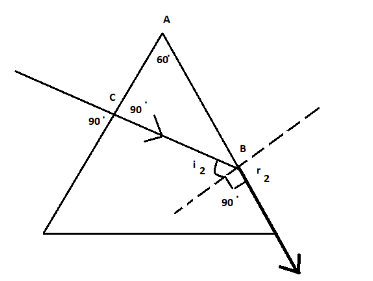
Answer
440.1k+ views
Hint:First of all, we will draw the diagram, which will show that the light ray enters at the right angle in the first face. Then we will use the angle sum property of a triangle, from where we can find the third angle, when we know the two angles of a triangle.
Complete step by step answer:
In the given problem, we are supplied with the following data:
A ray of light ray hits the face of the prism in a direction perpendicular to the plane.
Also given that the prism is an equilateral prism. We are asked to find the angle of incidence of the other face.To begin with, we will draw the diagram of the prism to have a better understanding.

From the diagram, we can say that the incident ray is normal to the plane. Hence, there is no phenomenon of refraction on this face because the incident ray hit this face in perpendicular direction, so we can write:
Angle of incidence on this face is \[{i_1} = {0{^\circ }}\] .
Angle of refraction on this face \[{r_1} = {0{^\circ }}\] .
Now, from the diagram, we need to find the angle \[ABC\] .
From the triangle \[ABC\], it is quite obvious that angle \[ACB\] is \[{90{^\circ }}\]. Since, the prism was an equilateral prism, so angle \[BAC\] is \[{60{^\circ }}\] .
So, by the angle sum property, which states that the sum of all the angles of a triangle is always \[{180{^\circ }}\] .
Now, we carry out the manipulations, which is given below:
$
\angle ABC + \angle BAC + \angle ACB = {180{^\circ }} \\
\Rightarrow\angle ABC + {60{^\circ }} + {90{^\circ }} = {180{^\circ }} \\
\Rightarrow\angle ABC = {180{^\circ }} - {60{^\circ }} - {90{^\circ }} \\
\therefore\angle ABC = {30{^\circ }} \\
$
Hence, the angle of incidence on the other face of the prism \[{30{^\circ }}\]. Thus, the correct option is B.
Note: It is important to note that you have seen that the light ray enters the prism at right angle, so it is quite obvious that the light ray had not suffered refraction. The light ray is undeviating in nature. So, remember that in this case, the angle of incidence and the angle of refraction on this face are both zero.
Complete step by step answer:
In the given problem, we are supplied with the following data:
A ray of light ray hits the face of the prism in a direction perpendicular to the plane.
Also given that the prism is an equilateral prism. We are asked to find the angle of incidence of the other face.To begin with, we will draw the diagram of the prism to have a better understanding.

From the diagram, we can say that the incident ray is normal to the plane. Hence, there is no phenomenon of refraction on this face because the incident ray hit this face in perpendicular direction, so we can write:
Angle of incidence on this face is \[{i_1} = {0{^\circ }}\] .
Angle of refraction on this face \[{r_1} = {0{^\circ }}\] .
Now, from the diagram, we need to find the angle \[ABC\] .
From the triangle \[ABC\], it is quite obvious that angle \[ACB\] is \[{90{^\circ }}\]. Since, the prism was an equilateral prism, so angle \[BAC\] is \[{60{^\circ }}\] .
So, by the angle sum property, which states that the sum of all the angles of a triangle is always \[{180{^\circ }}\] .
Now, we carry out the manipulations, which is given below:
$
\angle ABC + \angle BAC + \angle ACB = {180{^\circ }} \\
\Rightarrow\angle ABC + {60{^\circ }} + {90{^\circ }} = {180{^\circ }} \\
\Rightarrow\angle ABC = {180{^\circ }} - {60{^\circ }} - {90{^\circ }} \\
\therefore\angle ABC = {30{^\circ }} \\
$
Hence, the angle of incidence on the other face of the prism \[{30{^\circ }}\]. Thus, the correct option is B.
Note: It is important to note that you have seen that the light ray enters the prism at right angle, so it is quite obvious that the light ray had not suffered refraction. The light ray is undeviating in nature. So, remember that in this case, the angle of incidence and the angle of refraction on this face are both zero.
Recently Updated Pages
How many sigma and pi bonds are present in HCequiv class 11 chemistry CBSE

Mark and label the given geoinformation on the outline class 11 social science CBSE

When people say No pun intended what does that mea class 8 english CBSE

Name the states which share their boundary with Indias class 9 social science CBSE

Give an account of the Northern Plains of India class 9 social science CBSE

Change the following sentences into negative and interrogative class 10 english CBSE

Trending doubts
Fill the blanks with the suitable prepositions 1 The class 9 english CBSE

Which are the Top 10 Largest Countries of the World?

Difference between Prokaryotic cell and Eukaryotic class 11 biology CBSE

Difference Between Plant Cell and Animal Cell

The Equation xxx + 2 is Satisfied when x is Equal to Class 10 Maths

Give 10 examples for herbs , shrubs , climbers , creepers

Differentiate between homogeneous and heterogeneous class 12 chemistry CBSE

How do you graph the function fx 4x class 9 maths CBSE

Write a letter to the principal requesting him to grant class 10 english CBSE



